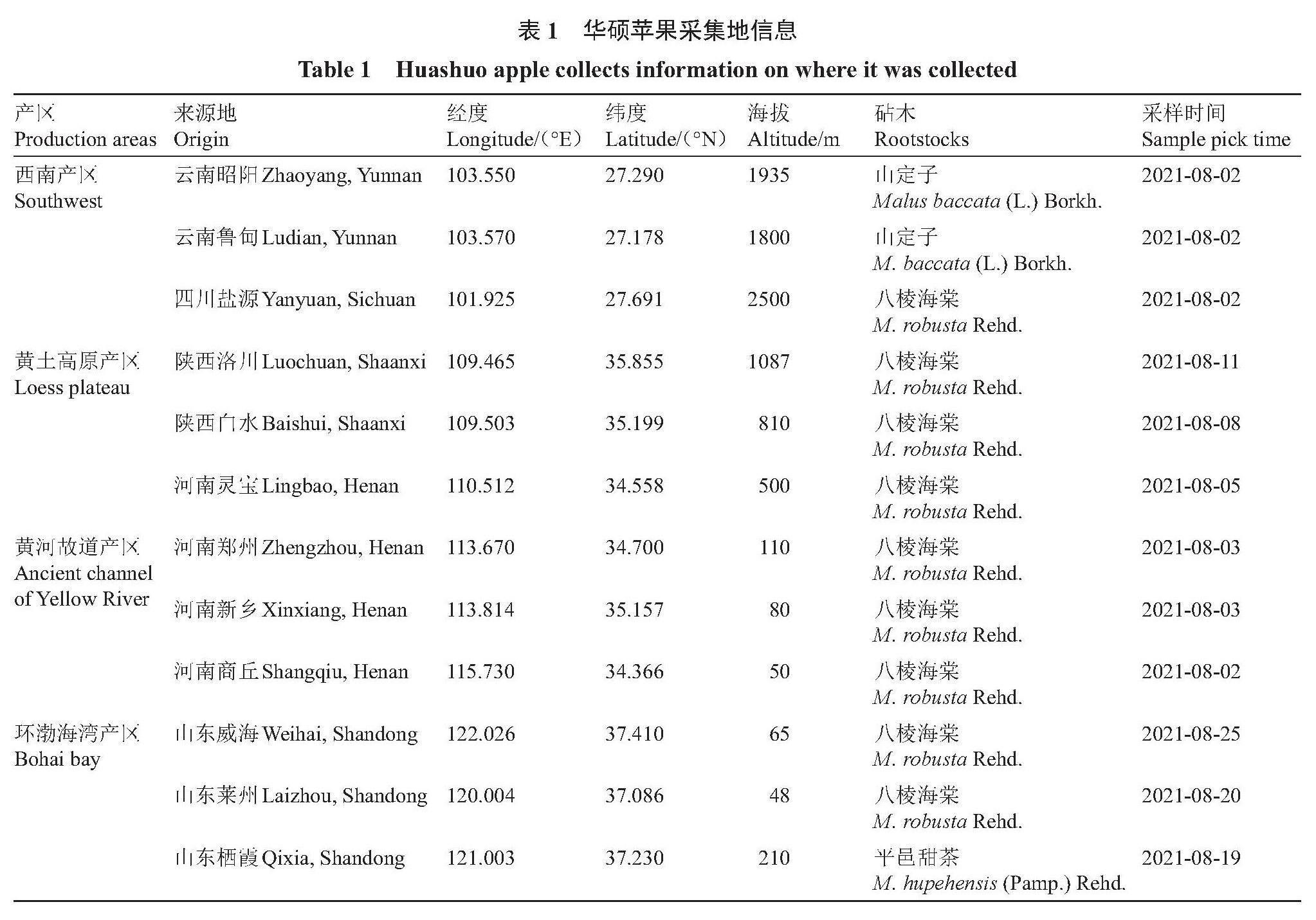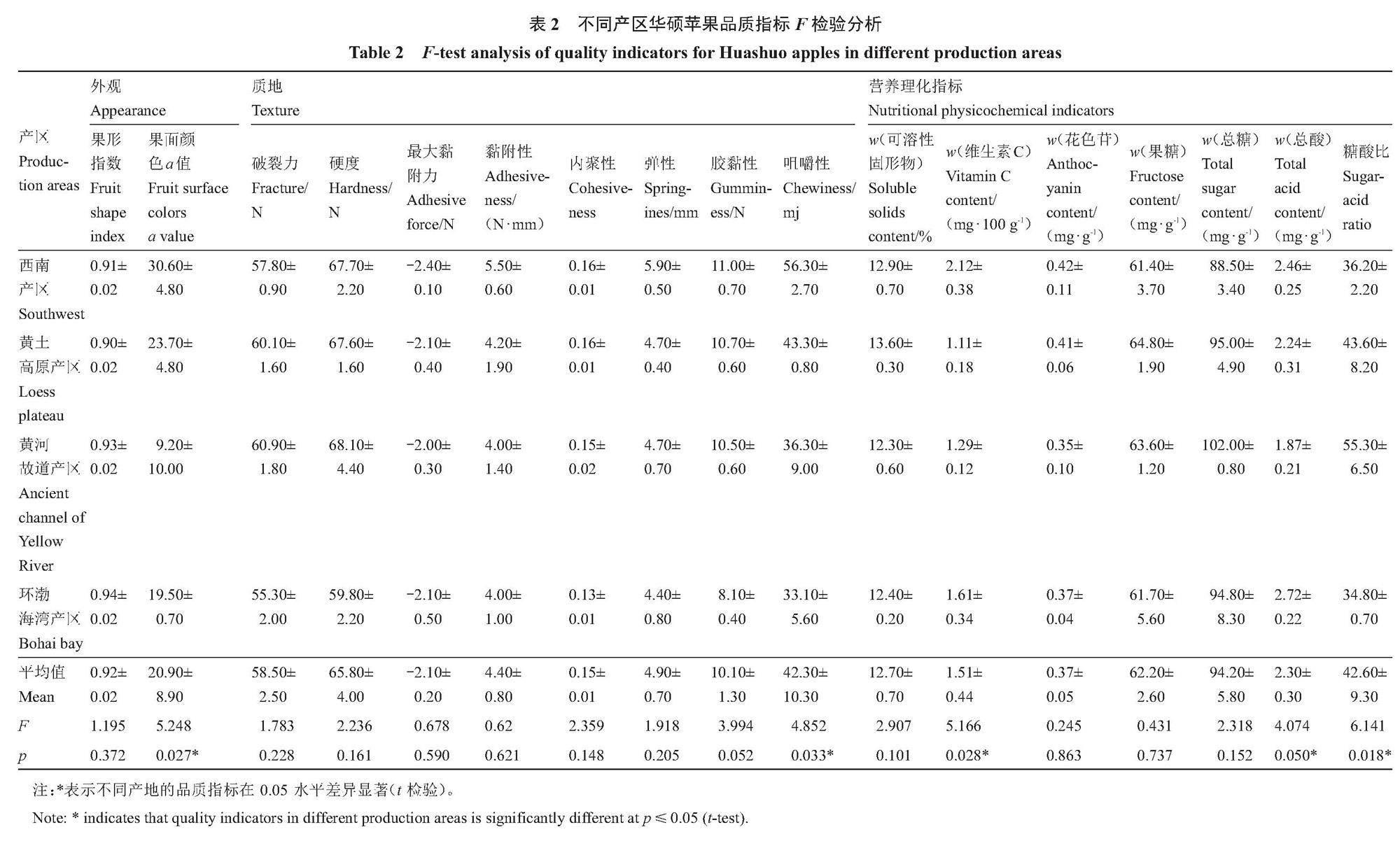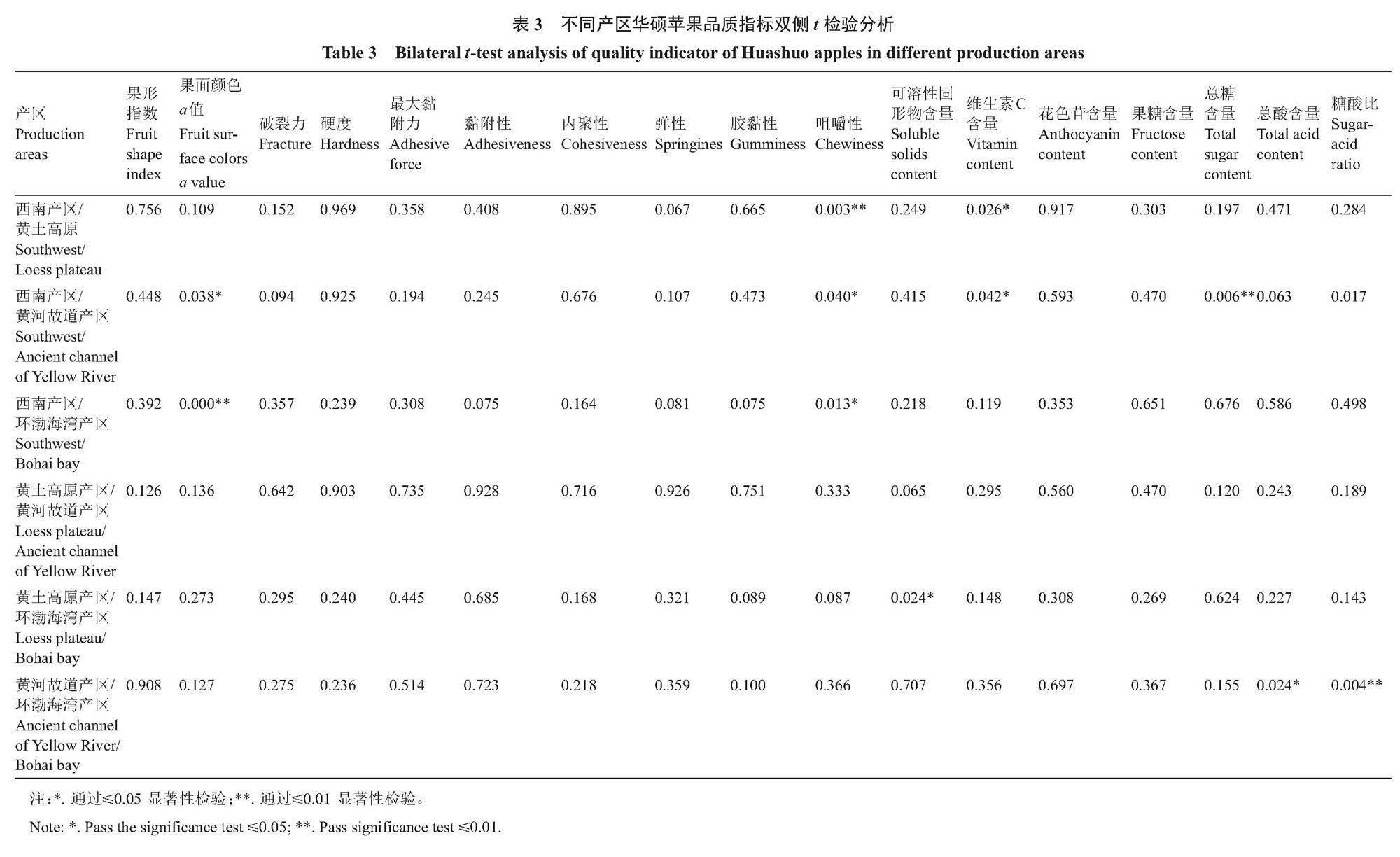不同产区华硕苹果品质差异性分析
鲁兴凯 马勉娣 谭安超 曾厅余 马静 吴冬 全勇



收稿日期:2023-08-07 接受日期:2023-11-05
基金项目:云南省昭通市鲲鹏计划-高层次领军人才项目
作者简介:鲁兴凯,男,农业推广研究员,研究方向为苹果科研与技术推广。E-mail:857095036@qq.com。#为共同第一作者。马勉娣,女,高级农艺师,硕士,研究方向为果树科研与技术推广。E-mail:1714070650@qq.com
*通信作者 Auther for correspondence. E-mail:56254981@qq.com;E-mail:563197296@qq.com
DOI:10.13925/j.cnki.gsxb.20230301
摘 要:【目的】分析和评价不同产区华硕苹果果实品质,为苹果品质评价、区域适应性研究和优化布局提供学术理论参考。【方法】用F检验和双侧t检验对不同产区间华硕苹果果实品质指标差异显著性分析,用变异系数权重法和TOPSIS法对分类品质性状和综合品质性状进行比较评价。【结果】(1)果面颜色a值、咀嚼性、维生素C含量、总酸含量和糖酸比5项指标不同产区间差异显著。(2)果面要素a值西南产区极显著高于环渤海湾产区,显著高于黄河故道产区;咀嚼性西南产区极显著高于黄土高原产区,显著高于黄河故道产区和环渤海湾产区;维生素C含量西南产区显著高于黄土高原产区和黄河故道产区;可溶性固形物含量黄土高原产区显著高于环渤海湾产区;总糖含量西南产区极显著低于黄河故道产区;总酸含量黄河故道产区显著低于环渤海湾产区。(3)西南产区外观品质性状和质地品质性状最优,黄河故道产区营养品质性状最优;综合得分西南产区25.804、黄土高原产区25.662、黄河故道产区25.541、环渤海湾产区20.865。【结论】不同产区华硕品质各有特点,综合评价西南产区最优、黄土高原产区其次、黄河故道产区和环渤海湾产区位列第三和第四,西南产区和黄土高原产区更有利于华硕品种优势和特色发挥。
关键词:华硕苹果; 品质;产区
中图分类号:S661.1 文献标志码:A 文章编号:1009-9980(2024)01-0030-11
Analysis on the difference in fruit quality of Huashuo apples from different areas
LU Xingkai1, MA Miandi1#, TAN Anchao1, ZENG Tingyu2*, MA Jing1, WU Dong1, QUAN Yong1*
(1Zhaotong Apple Industry Development Center, Zhaotong 657000, Yunnan, China; 2Zhaotong Meteorological Bureau, Zhaotong 657000, Yunnan, China)
Abstract: 【Objective】 Apple is the largest fruit in China, in terms of both planting area and production, making China the leading country in apple production and consumption worldwide. Over the course of more than a century, the cultivation of apples and advancements in scientific and technological progress have led to significant developments and transformations in the industry. This has resulted in the emergence of distinctive apple production areas in China, including the cold and cool highlands of Yunnan, Sichuan, and Guizhou provinces; the Bohai Bay area represented by Shandong, Liaoning, and Hebei provinces; the Ancient Channel of Yellow River area represented by eastern Henan and southwestern Shandong; and the Loess Plateau area represented by Shaanxi, Shanxi, western Henan, and Gansu provinces. These areas possess climatic factors that meet the growth and development requirements of apple trees. However, due to the vast territory of China and the wide distribution range of apple production areas, there exist significant variations and differences in geographical factors such as longitude, latitude, and altitude. Consequently, the same apple variety exhibits distinct quality characteristics in different production areas. To further explore and comprehensively analyze the quality differences of apples in these four production areas, this study focused on the current industry status, which is dominated by the late-maturing variety, Red Fuji, accounting for approximately 70% of the production, with a severe shortage of early-to-mid maturing varieties. The study selected the Huashuo variety, an early-maturing and high-quality variety independently bred in China as the research object in four superior production areas. Modern statistical analysis methods were applied to compare quality indicators, aiming to provide academic and theoretical references for apple variety quality evaluation, areal adaptability of excellent varieties, and planting layout and structural adjustment in China. 【Methods】 The fruits were selected from three different plots in the four dominant apple producing areas, including the cold and cool highland in southwest China, the Bohai Bay area, the Ancient Channel of Yellow River area, and the Loess Plateau area. The selected plots had relatively consistent combinations of tree age and planting patterns. Huashuo variety of apple trees in these plots were in their optimal harvesting period without bagging. A total of 2 appearance indicators (fruit shape index and fruit surface color a-value), 8 texture indicators (including fracture, hardness, maximum adhesion, adhesion, cohesion, etc.), and 7 nutritional and physicochemical indicators (such as soluble solids, vitamin C, fructose, total sugar, etc.) were measured. The differences in these 17 individual quality indicators were evaluated using the F-test. Furthermore, pairwise comparisons using bilateral t-test were conducted to assess the differences in quality indicators among the different production areas. The Coefficient of Variation Weighting Method was employed to evaluate the classification differences in appearance, texture, and nutritional and physicochemical quality indicators. Technique for Order of Preference by Similarity to Ideal Solution (TOPSIS) method was used to evaluate the comprehensive quality in the four production areas. This comprehensive research approach allowed for the assessment of differences in the 17 individual quality indicators and the overall quality comparison among the four dominant apple production areas. 【Results】 (1) The results of the F-test indicated that there were significant differences among the four production areas in five quality indicators, namely fruit surface color a-value, chewiness, vitamin C content, total acid, and sugar-acid ratio. However, there were no significant differences observed in the other twelve quality indicators. (2) The bilateral t-test revealed that the southwestern production area exhibited significantly higher color a value compared to the Bohai Bay area and the Ancient Channel of Yellow River area. In terms of chewiness, the southwestern production area showed significantly or extremely significantly higher values compared to the other production areas. The vitamin C content in the southwest production area was significantly higher than that in the Loess Plateau and the Ancient Channel of Yellow River areas. Soluble solid content in the Loess Plateau area was significantly higher than in the Bohai Bay area. The southwestern production area had a significantly lower total sugar content compared to the Ancient Channel of Yellow River area. The Ancient Channel of Yellow River area had a significantly lower total acid compared to the Bohai Bay area. The sugar-acid ratio in the Ancient Channel of Yellow River area was extremely significantly higher than that in the Bohai Bay area and significantly higher than that in the southwestern production area. (3) The Coefficient of Variation Weighting Method revealed that the appearance quality traits and texture quality traits were the best in the southwest production area; the nutritional quality traits in Ancient Channel of Yellow River area were the best. The comprehensive scores were 25.804, 25.662, 25.541 and 20.865 in southwestern production area, Loess Plateau area, Ancient Channel of Yellow River area and Bohai Bay area, respectively. Therefore, the southwestern production area had the highest overall score, while the Bohai Bay area had relatively poorer performance. (4) The TOPSIS comprehensive scoring method was employed to evaluate the performance of the different production areas. The southwestern production area achieved a score of 0.696, the highest overall evaluation. The Loess Plateau area obtained a score of 0.522, ranking second, while the Ancient Channel of Yellow River area received a score of 0.413, ranking third. The Bohai Bay area obtained the lowest score of 0.360, ranking fourth in the evaluation. 【Conclusion】 The four dominant apple production areas each exhibited distinct quality characteristics for the Huashuo variety. The climatic conditions and soil characteristics in the southwestern area may provide an ideal growth environment for the Huashuo variety, resulting in significant advantages in fruit surface color, texture, vitamin C content, total acidity, and sugar-acid ratio. The southwestern area ranked the first in terms of the comprehensive quality of Huashuo apples, followed by the Loess Plateau area, with the Ancient Channel of Yellow River area and Bohai Bay areas ranking the third and the fourth, respectively. Due to regional variations, consumer preferences, and differences among various consumer groups, certain quality indicators may not accurately reflect consumers preferences. The formation of apple quality is influenced by various factors, including geographical and climatic conditions, as well as cultivation management practices. Therefore, further in-depth exploration is needed to understand the underlying causes of quality differences in order to gain a comprehensive understanding of the factors contributing to these variations.
Key words: Huashuo apples; Quality; Production areas
Analysis on the difference in fruit quality of Huashuo apples from different areas
LU Xingkai1, MA Miandi1#, TAN Anchao1, ZENG Tingyu2*, MA Jing1, WU Dong1, QUAN Yong1*
(1Zhaotong Apple Industry Development Center, Zhaotong 657000, Yunnan, China; 2Zhaotong Meteorological Bureau, Zhaotong 657000, Yunnan, China)
Abstract: 【Objective】 Apple is the largest fruit in China, in terms of both planting area and production, making China the leading country in apple production and consumption worldwide. Over the course of more than a century, the cultivation of apples and advancements in scientific and technological progress have led to significant developments and transformations in the industry. This has resulted in the emergence of distinctive apple production areas in China, including the cold and cool highlands of Yunnan, Sichuan, and Guizhou provinces; the Bohai Bay area represented by Shandong, Liaoning, and Hebei provinces; the Ancient Channel of Yellow River area represented by eastern Henan and southwestern Shandong; and the Loess Plateau area represented by Shaanxi, Shanxi, western Henan, and Gansu provinces. These areas possess climatic factors that meet the growth and development requirements of apple trees. However, due to the vast territory of China and the wide distribution range of apple production areas, there exist significant variations and differences in geographical factors such as longitude, latitude, and altitude. Consequently, the same apple variety exhibits distinct quality characteristics in different production areas. To further explore and comprehensively analyze the quality differences of apples in these four production areas, this study focused on the current industry status, which is dominated by the late-maturing variety, Red Fuji, accounting for approximately 70% of the production, with a severe shortage of early-to-mid maturing varieties. The study selected the Huashuo variety, an early-maturing and high-quality variety independently bred in China as the research object in four superior production areas. Modern statistical analysis methods were applied to compare quality indicators, aiming to provide academic and theoretical references for apple variety quality evaluation, areal adaptability of excellent varieties, and planting layout and structural adjustment in China. 【Methods】 The fruits were selected from three different plots in the four dominant apple producing areas, including the cold and cool highland in southwest China, the Bohai Bay area, the Ancient Channel of Yellow River area, and the Loess Plateau area. The selected plots had relatively consistent combinations of tree age and planting patterns. Huashuo variety of apple trees in these plots were in their optimal harvesting period without bagging. A total of 2 appearance indicators (fruit shape index and fruit surface color a-value), 8 texture indicators (including fracture, hardness, maximum adhesion, adhesion, cohesion, etc.), and 7 nutritional and physicochemical indicators (such as soluble solids, vitamin C, fructose, total sugar, etc.) were measured. The differences in these 17 individual quality indicators were evaluated using the F-test. Furthermore, pairwise comparisons using bilateral t-test were conducted to assess the differences in quality indicators among the different production areas. The Coefficient of Variation Weighting Method was employed to evaluate the classification differences in appearance, texture, and nutritional and physicochemical quality indicators. Technique for Order of Preference by Similarity to Ideal Solution (TOPSIS) method was used to evaluate the comprehensive quality in the four production areas. This comprehensive research approach allowed for the assessment of differences in the 17 individual quality indicators and the overall quality comparison among the four dominant apple production areas. 【Results】 (1) The results of the F-test indicated that there were significant differences among the four production areas in five quality indicators, namely fruit surface color a-value, chewiness, vitamin C content, total acid, and sugar-acid ratio. However, there were no significant differences observed in the other twelve quality indicators. (2) The bilateral t-test revealed that the southwestern production area exhibited significantly higher color a value compared to the Bohai Bay area and the Ancient Channel of Yellow River area. In terms of chewiness, the southwestern production area showed significantly or extremely significantly higher values compared to the other production areas. The vitamin C content in the southwest production area was significantly higher than that in the Loess Plateau and the Ancient Channel of Yellow River areas. Soluble solid content in the Loess Plateau area was significantly higher than in the Bohai Bay area. The southwestern production area had a significantly lower total sugar content compared to the Ancient Channel of Yellow River area. The Ancient Channel of Yellow River area had a significantly lower total acid compared to the Bohai Bay area. The sugar-acid ratio in the Ancient Channel of Yellow River area was extremely significantly higher than that in the Bohai Bay area and significantly higher than that in the southwestern production area. (3) The Coefficient of Variation Weighting Method revealed that the appearance quality traits and texture quality traits were the best in the southwest production area; the nutritional quality traits in Ancient Channel of Yellow River area were the best. The comprehensive scores were 25.804, 25.662, 25.541 and 20.865 in southwestern production area, Loess Plateau area, Ancient Channel of Yellow River area and Bohai Bay area, respectively. Therefore, the southwestern production area had the highest overall score, while the Bohai Bay area had relatively poorer performance. (4) The TOPSIS comprehensive scoring method was employed to evaluate the performance of the different production areas. The southwestern production area achieved a score of 0.696, the highest overall evaluation. The Loess Plateau area obtained a score of 0.522, ranking second, while the Ancient Channel of Yellow River area received a score of 0.413, ranking third. The Bohai Bay area obtained the lowest score of 0.360, ranking fourth in the evaluation. 【Conclusion】 The four dominant apple production areas each exhibited distinct quality characteristics for the Huashuo variety. The climatic conditions and soil characteristics in the southwestern area may provide an ideal growth environment for the Huashuo variety, resulting in significant advantages in fruit surface color, texture, vitamin C content, total acidity, and sugar-acid ratio. The southwestern area ranked the first in terms of the comprehensive quality of Huashuo apples, followed by the Loess Plateau area, with the Ancient Channel of Yellow River area and Bohai Bay areas ranking the third and the fourth, respectively. Due to regional variations, consumer preferences, and differences among various consumer groups, certain quality indicators may not accurately reflect consumers preferences. The formation of apple quality is influenced by various factors, including geographical and climatic conditions, as well as cultivation management practices. Therefore, further in-depth exploration is needed to understand the underlying causes of quality differences in order to gain a comprehensive understanding of the factors contributing to these variations.
Key words: Huashuo apples; Quality; Production areas

